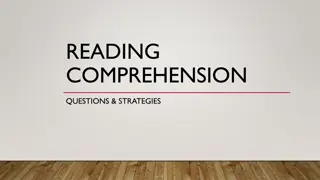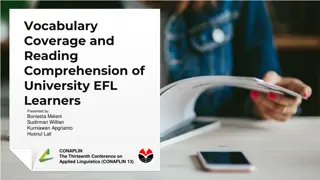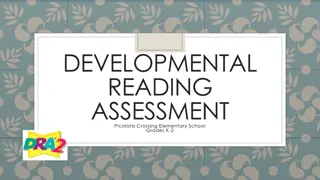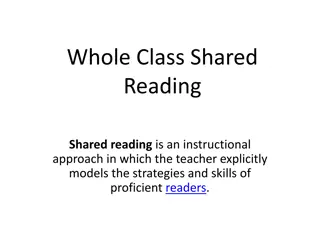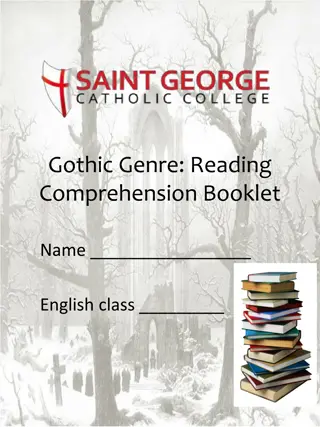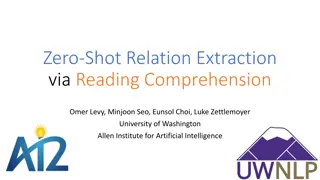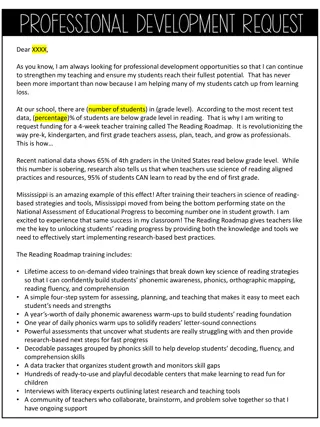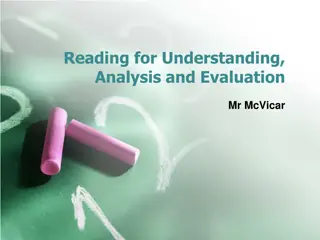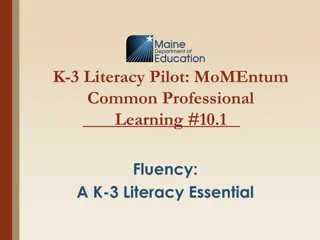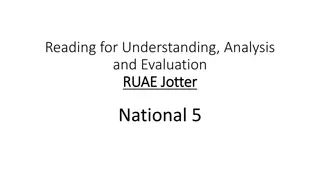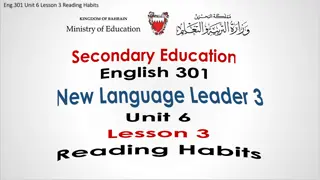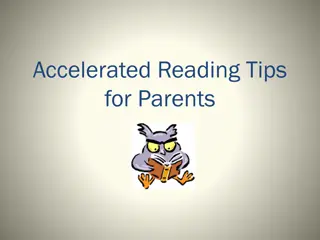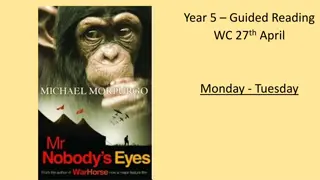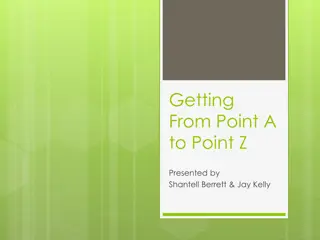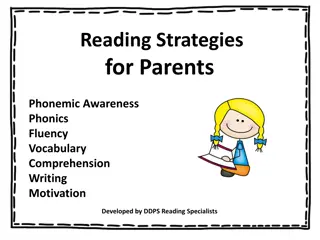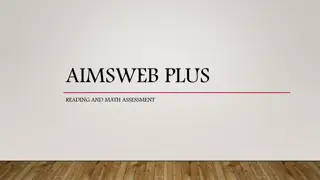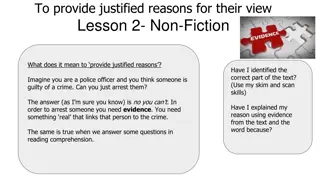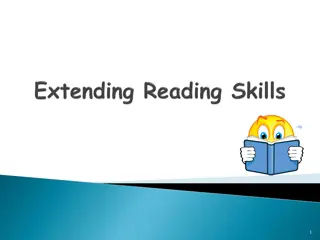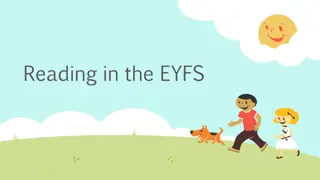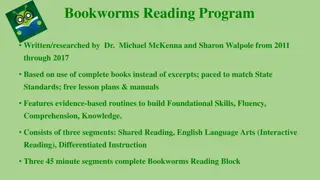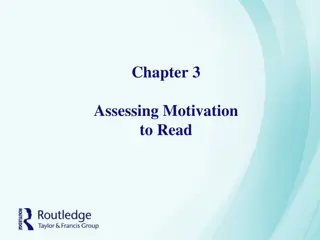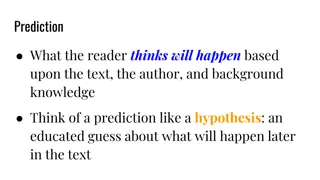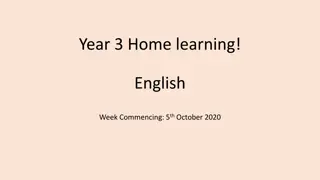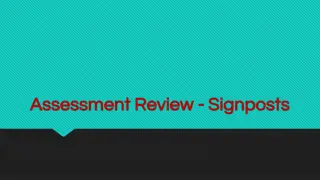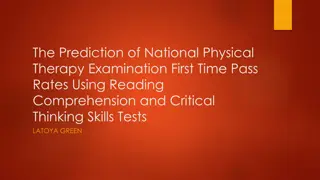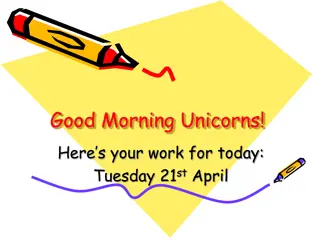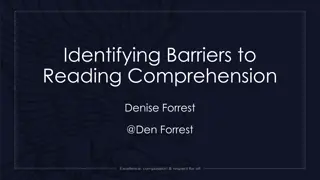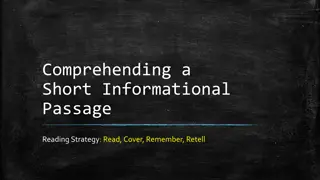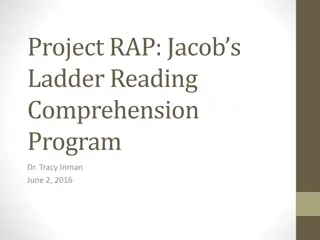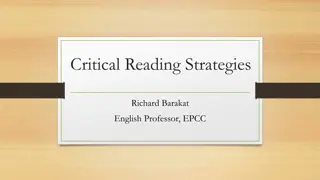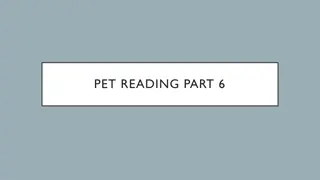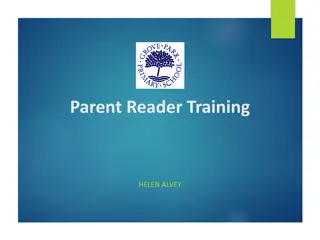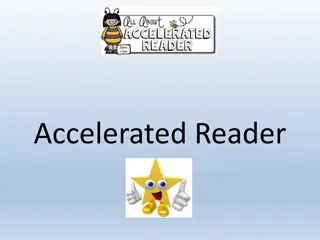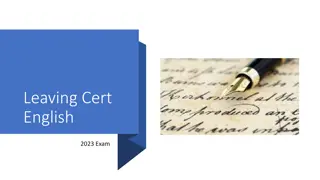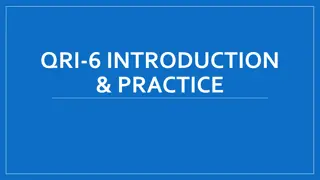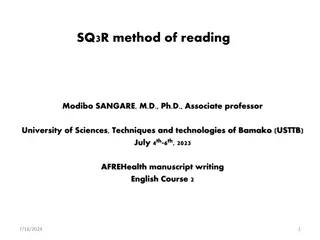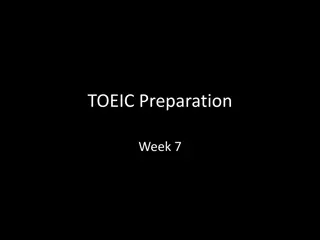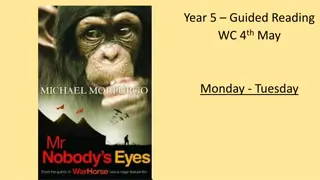Enhancing Reading Comprehension and Analysis Skills
Develop your reading comprehension and analysis skills by practicing techniques such as comparing passages, using flashcards for revision, and demonstrating understanding through bullet points. Apply these methods to analyze texts effectively, identify literary techniques, and extract key information. Strengthen your ability to evaluate and interpret written content through thoughtful reflection and practice.
Download Presentation

Please find below an Image/Link to download the presentation.
The content on the website is provided AS IS for your information and personal use only. It may not be sold, licensed, or shared on other websites without obtaining consent from the author. Download presentation by click this link. If you encounter any issues during the download, it is possible that the publisher has removed the file from their server.
E N D
Presentation Transcript
Higher RUAE Reading for Understanding, Analysis and Evaluation
The Exam Duration: 1 hour, 30 minutes Total marks: 30 2 passages 1stpassage + analysis questions = 25 marks Compare 1stand 2ndpassage (areas of agreements and/or disagreements) = 5 marks Use your checklist!
Revision Techniques Put every term and definition onto a flashcard AS YOU GO Read broadsheet newspaper articles and annotate them Use old past papers wisely Speak to me if you are unsure about any technique Use your checklist to reflect on progress
And Remember All techniques found in RUAE can be applied to your own writing. The more you use a linking sentence or try to think of relevant word choice, the more you will be able to identify and analyse these techniques. The more comfortable you are in analysing the imagery of a poem for critical reading, the more confident you will be in analysing unseen metaphors in RUAE
Understanding Most mistakes made here Practise is key! Hence Term 1 to show understanding of main ideas of each writer; to highlight any unknown vocabulary and to highlight as many techniques as possible Term 2 to show understanding of ideas and to analyse techniques that have been learned in RUAE or through analysis of class texts Term 3 to show understanding of all techniques, including tone created and how tone is created. To also compare ideas from different writers on same subject.
Show Understanding Own words Bullet points One point per mark Includes: Summarise points made Show understanding of word from context Show how sentence performs linking function
Example: Thinking of Grandpa now, I recall the clouds of pungent smoke that he puffed from his favourite briar, his small shrewd eyes, still very blue, and the gleaming dome rising from fleecy tufts of white hair Question What three characteristics of Grandpa does the author remember? 3 marks
Answer and Explanation She remembers her grandfather smoked a strong- smelling pipe. He also had intelligent blue eyes and a bald head with a little fluffy white hair. Explanation / Method Understanding of briar shown by using the word pipe Metaphor gleaming dome simplified to bald head Understanding of shrewd shown by using the word intelligent Grandpa is colloquial more formal term Grandfather is used Eyes is a common word, no obvious alternatives
Understanding Question Read lines 1 7 Explain in your own words why the writer seems surprised that there is so much coverage of the countryside debate . 2 marks Rural Mania The countryside debate has rarely been out of the news in Britain in recent years. Reading the newspapers, watching television, listening to the radio, entering a bookshop, one could be forgiven for thinking that we still live in small peasant communities dependent upon the minutest shift in agricultural policy. Sometimes it has seemed almost as if we were still in the early nineteenth century when we relied on the countryside to survive, so extensive have been the debates, so fierce the passions aroused.
Answer one could be forgiven for thinking that we still live in small peasant communities dependent upon the minutest shift in agricultural policy. Idea that we are still a rural society (1) affected by farming laws (1) it has seemed almost as if we were still in the early nineteenth century when we relied on the countryside to survive Idea that we are still living in the past (1) when we were more rurally dependent (1)
Understanding Question Read lines 21 29 Referring to lines 25 29, explain in your own words what the writer believes to be a particularly worrying aspect of the new rural mania (line 23). It might be thought indeed, it is widely assumed that it must be good for the countryside to be returned to the central position it enjoyed in British life long ago. Yet there is a particularly worrying aspect of the new rural mania that suggests it might finally do the countryside more harm than good. This is the identification, in the current clamour, of the countryside in general and the landscape in particular with the past the insistence on the part of those who claim to have the best intentions of ruralism at heart that their aim is to protect what they glibly refer to as our heritage . This wildly over-used term is seriously misleading, not least because nobody appears ever to have asked what it means.
Answer Any of the following ideas: That rural features are the only way of understanding our history Desire to preserve what is perceived as our heritage Difficulty in defining what is meant by the term our heritage Now complete practice questions in Higher English Language Skills
Remember You don t have to translate the text if words are already very simple you shouldn t have to change them. Read the passage as a whole what is it about? Do you get the jist? How many marks is this question worth? This should give you a clue as to how much information is necessary. Finally, never repeat phrases or complicated words these are the aspects of the passage you are being tested on!
Understanding context questions In Context questions, you will be asked to explain the meaning of a word or phrase, show how you deduced the meaning from its position in the text by quoting clues in the sentences surrounding the word. You must explain how they help to confirm the meaning. It is usually possible and advisable to quote two pieces of evidence.
Example The rumour that Douglas was a prisoner was still unsubstantiated. There had been no witnesses to his bailing out of the plane, and no solid information could be expected from beyond enemy lines for weeks, perhaps even months. Show how the context helped you arrive at the meaning of the word unsubstantiated.
Answer The word unsubstantiated means unconfirmed. The context conveys this: no witnesses who could say for sure the news was true, and the phrase no solid information also repeats the idea of there being no firm proof.
Example Glasgow s constant proclamation of its present success story is justified on the basis that it benefits the city: confidence will breed confidence, tourists will visit, businesses will relocate and students will enrol. But, despite the gains this approach has brought for Glasgow and cities like it, there are signs that the wind is starting to come out of the sails. What felt radical when Dublin, Barcelona and Glasgow embarked on the city makeover path in the late 1980s and early 1990s, now feels derivative and is delivering diminishing returns. When every city has commissioned a celebrity architect and pedestrianised a cultural quarter, distinctiveness is reduced to a formula. What does the writer mean by the words radical (line 13) and derivative (line 14) in his discussion of city development?
Answer Radical this means original, drastic, different. This is clear because the writer mentions cities employing popular architects celebrity architects and referring to the idea of the entire city being made different City makeover . Derivative unoriginal, imitative, copied. This is clear as the writer uses a list of other cities who have used a similar approach to highlight the extent that this has been done before. Now complete the examples in the language skills textbook.
Linking Sentence Show how once sentence provides a link in the argument. Quote the part of the sentence which refers back to the earlier topic Explain what this topic is Quote the part of the sentence which looks forward to the next topic Explain what this topic is This formula will NEVER change!!!
And when I hear politiciansmost of them comfortably offtrying to deny enlightenment and pleasure to working class people, I reach for my megaphone. Maybe Tommy Tattoo and his mates do use cheap flights to the sunshine as an extension of their binge-drinking opportunities, but for thousands of people whose parents would never have ventured beyond Blackpool or Rothesay, air travel has been a social revelation. So, before we all give the eco-lobby s anti-flying agenda the unconditional benefit of the doubt, can we just review their strategy as a whole? Remember, it is not just air travel that the green tax lobby is trying to control: it is a restriction on any mobility. Clamping down on one form of movement, as the glib reformers have discovered, simply creates intolerable pressure on the others. Londoners, for example, had just become accustomed to the idea that they would have to pay an 8 congestion charge to drive into their own city when they discovered that the fares on commuter rail and underground services had been hiked up with the intention of driving away customers from the public transport system now grossly overcrowded as a result of people having been forced off the roads by the congestion charge.
Question Referring to specific words and/or phrases, show how the sentence So, before as a whole? (lines 13-14) performs a linking function in the writer s argument.
Answer Four elements are required: 1 eco-lobby s anti-flying agenda 2 refers back to the restrictive air travel proposals discussed in the opening two paragraphs; 3 their strategy as a whole / can we just review 4 leads into the discussion of the eco- lobby s proposed restrictions on travel as a whole/on energy use in general
Example William Shakespeare is easily the best-known of our English writers. Virtually every man in the street can name some of his plays and his characters, and many people can also recite lines of his poetry by heart. However, despite our familiarity with his work, we know relatively little of the man himself. We do not know when or why he became an actor, we know nothing of his life in London, and almost nothing of his personal concerns. Question Show how the third sentence acts as a link in the argument.
Answer The conjunction however which begins the sentence suggests a contrasting idea to follow. The phrase our familiarity with his work looks back at the topic of how widely know Shakespeare s work is. The second part of the sentence, we know relatively little of the man himself , introduces the new topic, namely the things that are not known about Shakespeare, and a list of these follows this link sentence Now complete questions in language skills book.
Revision Read the comments/opinion sections of broadsheet newspapers Pick out two paragraphs from each and summarise the main points made by the writer Highlight a linking sentence and explain how it performs a linking function Find a word you don t understand and attempt to figure it out from the context then look it up to check that you were right.
Figures of Speech Imagery (simile, metaphor, personification) sight Alliteration Onomatopoeia Pun Hyperbole Litotes (understatement) Circumlocution Euphemism Paradox Oxymoron Juxtaposition Neologism Archaism Clich New, old and overused sound Overstating understating talking in circles Contrasts, opposites, contradictions
Imagery An imagery questions will require you to focus on analysing metaphor, simile or personification. There are different styles of answering this question, however we will focus on using the just as, so it is, this is effective because method.
When I was 18 I travelled to Indonesia. When I returned home I held the inevitable slideshow for long-suffering friends. There was a shot of an old farmer. He was as sinewy as a Balinese carving. He stands, unsmiling, holding onto some willowy branches, as if he has indeed been hewn from the tree. Don t you mind taking pictures of people? asked a friend. I thought it a strange question. There was a perfect picture opportunity and I made the most of it.
Just as a Balinese carving features lots of thin intricate lines, so it is in the passage that the farmer is slim with sinews in his body that form lots of intricate and patterned lines. This is effective becauseit highlights what an attractive subject the farmer is for a photograph as he looks like a work of art. Given that writer is questioned about why he takes such photographs, it strengthens his argument that it was indeed a perfect picture opportunity .
Near Bombay there are historic caves which are a popular day-trip destination. Climbing several hundred steps, you are assaulted by trinket-sellers, caf owners, monkeys and, most bizarre of all, village women with empty water-pots on their heads. They run ahead of you to pose stiffly and insist that you take a picture. Then they ask for money. These women know what tourists want: an authentic look. No plastic water containers, please.
Just as an assault involves attacking someone forcefully and perhaps unexpectedly, so it is in the passage that the various village people unexpectedly surround the writer, almost attacking him as they approach and offer themselves as possible subjects for a photograph. This is effective becauseit highlights how keen these people are to have their photograph taken and also gives a sense of how many there are. The negative connotations of assault underline the writer s point that this is not an altogether pleasant experience.
I am inclined to see the shape of British post-war history as having been not unlike that of a gigantic wave. It was a wave which began to gather in the mid-Fifties, as the world finally began to emerge from the shadows cast by the Second World War a wave of expectation, of nervous excitement, born of the growing sense that somehow Britain, the West and mankind were moving forward into a new era, of a kind never known before.
Just as a gigantic wave is a large, fast, overpowering and frightening force that can destroy everything in its path and change the landscape forever; so it is in the passage that British post-war history is a period of time when a lot of things changed forever, at a frightening speed and with a powerful force that moved into the next century. This is effective because the comparison allows us to look back over history and appreciate the sheer scale and speed in which everything changed.
Above all in the late Sixties there were the first signs of a growing weariness with the relentless battering of change. Around 1967, we suddenly began to hear a new set of words conservation , the environment , pollution , ecology expressing a growing sense of horror at what our wonderful, runaway technology was doing to our cities, to our countryside and rivers and seas, to other species, to the whole balance of nature on the planet. Somehow, the feeling ran, things seemed to have got out of hand.
Having invented the modern city, 19th century Britain promptly reeled back in horror at what it had done. To the Victorians exploring the cholera-ridden back alleys of London s East End, the city was a hideous tumour sucking the life out of the countryside and creating in its place a vast polluted landscape of squalor, disease and crime. In their eyes, the city was a place to be feared, controlled and, if possible, eliminated.
Figures of Speech - Sound Alliteration: A series of words in which the same letter is repeated, usually at the beginning of two or more words in order to create a particular effect. He carried a box of books up to the storeroom on the top floor of the building. There are three words beginning with b here but all of them are simple nouns and there does not appear to be any particular literary effect intended. However, when the travel writer Patrick Leigh-Fermor, describing a town in Holland, talks about the clip-clop of clogs on the cobblestones the alliteration is clearly deliberate: you can almost hear the rhythmical sound of the wooden shoes on the street.
Figures of Speech - Sound Onomatopoeia is a name given to words which imitate the sound they are describing. Often used in conjunction with alliteration. As in the above quotation, alliteration helps to create an onomatopoeic effect. This is how D.H. Lawrence describes a snake drinking from a water trough in his poem Snake: He sipped with his straight mouth, Softly drank through his straight gums, into his slack long body, Silently. The alliteration of the letter s (also known as sibilance) creates a hissing effect appropriate to a description of a snake.
Figures of Speech - Sound Pun: a play on words involving words which sound similar but have different meanings. Usually the intended effect is humour Waiter! Yes sir? What s this supposed to be? It s bean soup, sir. I don t care what it s been. What is it now?
Figures of Speech overstating, understating, talking in circles Hyperbole is a deliberate exaggeration in order to emphasise the point being made often for a humorous effect. The television presenter Clive James often uses this technique with great skill. He describes Marlon Brando as Hollywood s number one broody outcast and says that: He could order a cheeseburger with fries and make it sound like a challenge to the Establishment. Extract from Fame in the Twentieth Century by Clive James
Figures of Speech overstating, understating, talking in circles Litotes is the opposite of hyperbole: deliberate understatement. In My Family and Other Animals, Gerald Durrell writes of his mother: On Monday morning I found her in the garage being pursued round and round by an irate pelican which she was trying to feed with sardines from a tin. I m glad you ve come dear, she panted, this pelican is a little difficult to handle. As with so many other figures of speech, hyperbole and litotes are not confined to writing but are often used in everyday conversation: Isn t there anything to drink? I m dying of thirst! (Hyperbole) The teacher wasn t exactly overjoyed when I told her that I d left my work at home. (Litotes)
Figures of Speech overstating, understating, talking in circles Euphemism: a way of making an unwelcome truth seem less harsh or unpleasant by dressing it up in inoffensive language. Many euphemisms are connected with the subject of death, e.g. saying passed away rather than died . Euphemisms are equally plentiful in the world of politics. One of the most famous examples came from the 1950s Prime Minister, Sir Anthony Eden, who once said We are not at war with Egypt. We are in a state of armed conflict.
Figures of Speech contrasts, opposites and contradictions Paradox: a statement which appears to be a contradiction but which, on closer examination, does contain a truth. For example, to preserve the peace, prepare for war This seems to be a contradiction, but it is based on the deterrent idea that if one side builds up its military strength then the enemy will not dare to attack, and thus peace will be maintained. The oft-quoted comment by Oscar Wilde is an example of paradox: Nowadays people know the price of everything, and the value of nothing.
Figures of Speech contrasts, opposites and contradictions Oxymoron: a condensed form of paradox, in which two opposites are place side by side to heighten the effect of contrast. Edwin Muir s poem The Horses ends with horses coming to a group of human survivors of a nuclear war and voluntarily allowing themselves to be used to plough the land: the poet describes their action as: free servitude .
Figures of Speech contrasts, opposites and contradictions Juxtaposition simply means placing side by side. In the example of oxymoron, it could be said that the two opposites are placed in juxtaposition. A writer might deliberately place two sentences beside each other to highlight the contrast between them. Dustin Hoffman became famous in the sixties in The Graduate playing a nervous young man who suspected that life in America was stacked against him. In the seventies he became more famous still as an even more nervous, slightly less young man, who knew that life in America was stacked against him.
Figures of Speech new, old and overused Neologism: coining of a new word, usually to describe a recent development or invention for which an appropriate term does not exist. microwave oven, filofax, sky plus, video-conferencing Archaism: denotes a word from the past which is no longer in current use, the opposite of neologism. Arm thyself lightly, mount to horse, keep thy land, aid thy men, hurtle into the press. Thou needest not to strike another, neither to be smitten down. A writer may deliberately try to write in an archaic style in an attempt to recapture the feel of a historical period. Clich : an expression which at one time might have been original but has now become overused, in this day and age or as white as snow are clich s and should be avoided like the plague
A wee test Next week there will be a wee class quiz to test your knowledge of all the language techniques you have learned so far If you do not know any, you will be required to write out their definitions five times each.
Word Choice Once you feel confident in answering questions relating to word choice, you may find that this is one of the easiest ways to pick up marks. Main thing to always focus on CONNOTATIONS AND EFFECTS
Look out for Verbs Adverbs Adjectives Stress words will, should, have to, might, can t, won t never, always, often, sometimes, maybe


